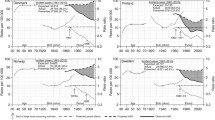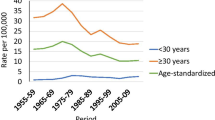Abstract
Age-incidence relationships are informative of carcinogenic mechanisms. These have been previously assessed for cervical squamous cell carcinoma (SCC) but not for adenocarcinoma. The aim was to assess by means of age-, period- and cohort- specific analyses and Poisson regression modelling whether the two types of cervical cancer show an age-incidence maximum at a relatively young age, as shown in cross-sectional analyses. The Swedish Family-Cancer Database was used to analyse age-incidence relationships in cervical SCC and adenocarcinoma diagnosed in years 1958–1996, including a total of 15,118 and 1866 cases, respectively. Area of residence and socio-economic status were included in analyses because they were risk factors of cervical cancer. The analysis of cervical SCC confirmed an incidence maximum at ages 35–39 years. The data for adenocarcinoma also suggested a similar early age maximum but the curves differed extensively by birth cohort. The incidence of adenocarcinoma increased substantially at young age groups towards the end of follow-up. Endometrial adenocarcinoma and vaginal and vulvar SCC, which share some risk factors with cervical cancer, did not show an early age incidence maximum. The results also showed that there was a decrease in the incidence of cervical SCC around year 1960, almost 10 years before the organized population screening, probably due to introduced opportunistic pap testing. The benefits of the organized screening were observed as a further decline in the incidence rates. The unique age-incidence relationships in cervical cancer call for biological explanations.
Similar content being viewed by others
References
Pisani P, Parkin D, Munoz N, Ferlay J. Cancer and infection: Estimates of the attributable fraction in 1990. Cancer Epidemiol Biomarkers Prev 1997; 6: 387–400.
IARC. Human papillomaviruses. Lyon: IARC, 1995.
Vizcaino A, Moreno V, Bosch F, et al. International trends in incidence of cervical cancer: II. Squamous-cell carcinoma. Int J Cancer 2000; 86: 429–435.
Björge T, Hakulinen T, Egeland A, et al. A prospective, seroepidemiological study of the role of human papillomavirus in esophageal cancer in Norway. Cancer Res 1997; 57: 3989–3992.
Gillison M, Koch W, Capone R, et al. Evidence for a causal association between human papillomavirus and a subset of head and neck cancers. J Natl Cancer Inst 2000; 92: 709–720.
Hakama M, Miller A, Day N. Screening for cancer of the uterine cervix. In: IARC Sci Publ. Lyon: IARC, 1986.
IARC. Cancer: Causes, Occurrence and Control. Lyon: IARC, 1990.
Beral V, Hermon C, Munoz N, Devesa S. Cervical cancer. Cancer Surv 1994; 19–20: 265–285.
Anttila A, Pukkala E, Söderman B, Kallio M, Nieminen P, Hakama M. Effect of organized screening on cervical cancer incidence and mortality in Finland, 1963–1995: Recent increase in cervical cancer incidence. Int J Cancer 1999; 83: 59–65.
Vizcaino A, Moreno V, Bosch F, Munoz N, Barros-Dios X, Parkin D. International trend in the incidence of cervical cancer: I Adenocarcinoma and adenosquamous cell carcinoma. Int J Cancer 1998; 75: 536–545.
Armitage P, Doll R. The age distribution of cancer and a multi-stage theory of carcinogenesis. Br J Cancer 1954; 8: 1–12.
Armitage P, Doll R. A two-stage theory of carcinogenesis in relation to the age distribution of human cancer. Br J Cancer 1957; 9: 161–169.
Moolgavkar S, Knudson Jr A. Mutation and cancer: A model for human carcinogenesis. J Natl Cancer Inst 1981; 66: 1037–1052.
Moolgavkar S, Luebeck E. Multistage carcinogenesis: Population-based model for colon cancer. J Natl Cancer Inst 1992; 84: 610–618.
Kinzler K, Vogelstein B. Lessons from hereditary colorectal cancer. Cell 1996; 87: 159–170.
Herrero-Jimenez P, Thilly G, Southam P, et al. Mutation, cell kinetics, and subpopulations at risk for colon cancer in the United States. Mut Res 1998; 400: 553–578.
Herrero-Jimenez P, Tomita-Mitchell A, Furth E, Morgenthaler S, Thilly W. Population risk and physiological rate paramenters for colon cancer. The union of an explicit model for carcinogenesis with the public health records of the United States. Mut Res 2000; 447: 73–116.
Cook P, Doll R, Fillingham S. A mathematical model for the age distribution of cancer in man. Int J Cancer 1969; 4: 93–112.
Gustafsson L, Ponten J, Bergstrom R, Adami H-O. International incidence rates of invasive cervical cancer before cytological screening. Int J Cancer 1997; 71: 159–165.
Rostgaard K, Väth M, Holst H, Madsen M, Lynge E. Age-period-cohort modelling of breast cancer incidence in the Nordic countries. Statist Med 2001; 20: 47–61.
Pettersson F, Bjorkholm E, Naslund I. Evaluation of screening for cervical cancer in Sweden: Trends in incidence and mortality 1958–1980. Int J Epidemiol 1985; 14: 521–527.
Bergstrom R, Sparen P, Adami H-O. Trends in cancer of the cervix uteri in Sweden following cytological screening. Br J Cancer 1999; 81: 159–166.
Pollack E. Cancer incidence trends in the United States: Some methodological problems. In: Magnus K, (ed.), Trends in Cancer Indicence, New York: Hemisphere, 1982; pp. 17–49.
Jin F, Devesa S, Chow W-H, et al. Cancer incidence trends in urban Shanghai, 1972–1994: An update. Int J Cancer 1999; 83: 435–440.
Hemminki K, Dong C, Vaittinen P. Familial risks in cervix cancer: Is there a hereditary component? Int J Cancer 1999; 82: 775–781.
Esteve J, Benhamou E, Raymond L. Statistical Methods in Cancer Research. Lyon: IARC, 1994.
Clayton D, Schifflers E. Models for temporal variation in cancer rates. I: Age-period and age-cohort models. Stat Med 1987; 6: 449–467.
Clayton D, Schifflers E. Models for temporal variation in cancer rates. II: Age-period-cohort models. Stat Med 1987; 6: 469–481.
Hemminki K, Dong C. Cancer in husbands of cervical cancer patients. Epidemiology 2000; 11: 347–349.
Pukkala E, Weiderpass E. Time trends in socio-economic differences in incidence rates of cancers of the breast and female genital organs (Finland, 1971–1995). Int J Cancer 1999; 81: 56–61.
Author information
Authors and Affiliations
Rights and permissions
About this article
Cite this article
Hemminki, K., Li, X. & Mutanen, P. Age-incidence relationships and time trends in cervical cancer in Sweden. Eur J Epidemiol 17, 323–328 (2001). https://doi.org/10.1023/A:1012761717028
Issue Date:
DOI: https://doi.org/10.1023/A:1012761717028




